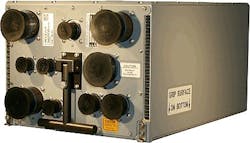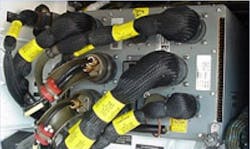PHILADELPHIA, 3 May 2013. U.S. Navy avionics experts are looking to General Dynamics Advanced Information Systems in Bloomington, Minn., for maintenance and upgrades on six flight computers for the Navy's F/A-18E/F Super Hornet, EA-18G Growler, and AV-8B Harrier strike fighter and electronic warfare combat jets.
The Naval Supply Weapon Systems Support activity in Philadelphia is awarding General Dynamics a five-year $31.5 million performance-based logistics requirements contract for the combat aircraft flight computers, which are considered mission critical to operations of these aircraft, Navy officials say.
The Navy is awarding the contract sole-source to General Dynamics. This is an urgent requirement and only General Dynamics was asked to bid on the contract, as the company is the manufacturer of flight computers for these aircraft.
General Dynamics Advanced Information Systems designs and builds the Type 3 Advanced Mission Computers (AMCs) for the Super Hornet and Growler aircraft, as well as The Mission Systems Computer (MSC) for the AV-8B Harrier jump jet.
The AMC is a rugged embedded computer that performs general purpose, I/O, video, voice, and graphics processing. Communication is over several buses, including 1553, Fibre Optic Fibre Channel, and Local PCI.
Single-board computers and other modules in the AMC fit in an industry standard 6U VME backplane, and the I/O configuration may be tailored with PMC mezzanine card (PMC) modules. An Ethernet interface supports software development and system maintenance.
The AMC's core system software (CSS) is a real-time operating system with embedded system software, application program interface, and diagnostic software set for the AMC. The computer's I/O includes MIL-STD-1553 drivers, Fibre Channel drivers, VMEbus drivers, and discrete and serial I/O drivers.
The AV-8B's mission computer is a VME-based processing system based on the Freescale Power-PC open-systems processor architecture. The mission computer can control mission computers and displays, digital maps, network processors, and servers.
General Dynamics, in a separate Navy contract, also is upgrading the MSC in the AV-8B with industry-standard interfaces that meet guidelines of the Future Airborne Capability Environment (FACE), by providing the MSC with a FACE interface structure running on top of the system's existing Wind River Systems VxWorks 5.5-based core systems software.
The FACE technical standard, administered by the FACE industry consortium, providing guidelines for creating a common operating environment to support applications across U.S. military avionics systems. The standard helps enable developers to create and deploy applications across many military aviation systems through a common operating environment.
On the flight computer upgrade contract, General Dynamics will do the work in Bloomington, Minn., and should be finished by April 2018. For more information contact General Dynamics Advanced Information Systems online at www.gd-ais.com, or the Naval Supply Weapon Systems Support activity at www.navsup.navy.mil.




